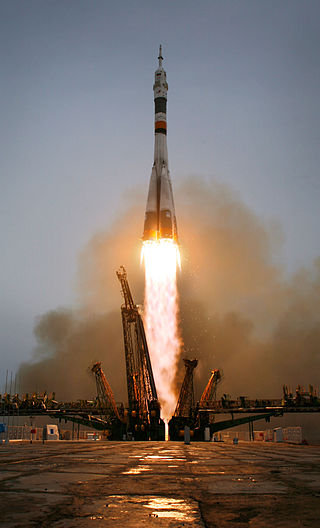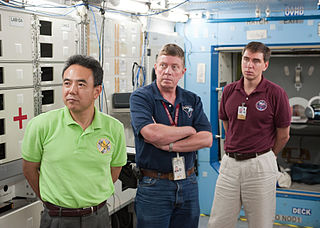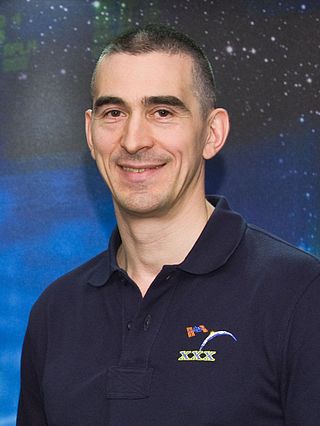
Soyuz TMA-3 was a Soyuz mission to the International Space Station (ISS) launched by a Soyuz FG launch vehicle which was the third flight for the TMA modification of the Soyuz spacecraft, and the 7th Soyuz to fly to the ISS.

André Kuipers is a Dutch physician and ESA astronaut. He became the second Dutch citizen, third Dutch-born and fifth Dutch-speaking astronaut upon launch of Soyuz TMA-4 on 19 April 2004. Kuipers returned to Earth aboard Soyuz TMA-3 11 days later.

Akihiko Hoshide is a Japanese engineer, JAXA astronaut, and former commander of the International Space Station. On August 30, 2012, Hoshide became the third Japanese astronaut to walk in space.
A mission patch is a cloth reproduction of a spaceflight mission emblem worn by astronauts and other personnel affiliated with that mission. It is usually executed as an embroidered patch. The term space patch is mostly applied to an emblem designed for a crewed space mission. Traditionally, the patch is worn on the space suit that astronauts and cosmonauts wear when launched into space. Mission patches have been adopted by the crew and personnel of many other space ventures, public and private.

Oleg Dmitriyevich Kononenko is a Russian cosmonaut. He has flown to the International Space Station five times as a flight engineer for Expedition 17 aboard Soyuz TMA-12, as a flight engineer on Expedition 30 and commander of Expedition 31 aboard Soyuz TMA-03M, as a flight engineer on Expedition 44 and Expedition 45 aboard Soyuz TMA-17M, as a flight engineer on Expedition 57 and commander of Expedition 58 and Expedition 59 aboard Soyuz MS-11, and as a flight engineer on Expedition 69 and Expedition 70 and commander of Expedition 71 aboard Soyuz MS-24/Soyuz MS-25.

The Soyuz TMA-14 was a Soyuz flight to the International Space Station, which launched on 26 March 2009. It transported two members of the Expedition 19 crew as well as spaceflight participant Charles Simonyi on his second self-funded flight to the space station. TMA-14 was the 101st crewed flight of a Soyuz spacecraft, including launch failures; however, it was the 100th to launch and land crewed, as Soyuz 34 was launched uncrewed to replace Soyuz 32, which landed empty.

Soyuz TMA-17 was a human spaceflight mission to the International Space Station (ISS). TMA-17 crew members participated in ISS Expedition 22 and Expedition 23. The mission ended when the Soyuz TMA-17 capsule landed on 2 June 2010.

Soyuz TMA-18 was a 2010 Soyuz flight to the International Space Station (ISS). TMA-18 was the 105th crewed flight of a Soyuz spacecraft since the first crewed flight in 1967.

Soyuz TMA-19 was a crewed spaceflight to the International Space Station (ISS) and is part of the Soyuz programme. It was launched on 15 June 2010 carrying three members of the Expedition 24 crew to the International Space Station, who remained aboard the station for around six months. Soyuz TMA-19 was the 106th crewed flight of a Soyuz spacecraft, since the first mission which was launched in 1967. The spacecraft remained docked to the space station for the remainder of Expedition 24, and for Expedition 25, to serve as an emergency escape vehicle. It undocked from ISS and landed in Kazakhstan on 26 November 2010. It was the 100th mission to be conducted as part of the International Space Station programme since assembly began in 1998.

Soyuz TMA-20 was a human spaceflight to the International Space Station (ISS) and was part of the Soyuz programme. It lifted off from the Baikonur Cosmodrome in Kazakhstan on December 15, 2010, and docked with the ISS two days later. The three-person crew of Soyuz TMA-20 – Dmitri Kondratyev, Catherine Coleman and Paolo Nespoli – represented the ISS partner organizations of Roscosmos, NASA and the European Space Agency (ESA). Soyuz TMA-20's crew represented half of the members of Expedition 27; the other three members of the expedition arrived at the station on board Soyuz TMA-21 on April 6, 2011. The COSPAR ID of Soyuz TMA-20 was 2010-067A. It is ISS flight 25S.

Expedition 26 was the 26th long-duration mission to the International Space Station. The expedition's first three crew members – one US astronaut and two Russian cosmonauts – arrived at the station on board Soyuz TMA-01M on 10 October 2010. Expedition 26 officially began the following month on 26 November, when half of the crew of the previous mission, Expedition 25, returned to Earth on board Soyuz TMA-19. The rest of the Expedition 26 crew – one US astronaut, one Russian cosmonaut and one ESA astronaut – joined the trio already on board when their spacecraft, Soyuz TMA-20, docked with the station on 17 December 2010.

Expedition 29 was the 29th long-duration expedition to the International Space Station (ISS). The expedition formally began on 16 September 2011, with the departure from the ISS of the Soyuz TMA-21 spacecraft. Astronauts Satoshi Furukawa, Michael Fossum and Sergey Volkov, who had arrived at the ISS aboard Soyuz TMA-02M in June 2011, began their Expedition 29 service at this time.

Soyuz TMA-02M was a space mission that transported three members of the Expedition 28 crew to the International Space Station. TMA-02M was the 110th flight of a Soyuz spacecraft and the second flight of the improved Soyuz-TMA-M series. The Soyuz remained docked to the space station for the Expedition 28 increment to serve as a potential emergency escape vehicle.

Kjell Norwood Lindgren is an American astronaut who was selected in June 2009 as a member of the NASA Astronaut Group 20. He launched to the International Space Station (ISS) as part of Expedition 44/45 on July 22, 2015.

Soyuz TMA-22 was a crewed spaceflight to the International Space Station (ISS). TMA-22 was the 111th flight of a Soyuz spacecraft, and transported three members of the Expedition 29 crew to the ISS. The spacecraft docked to the ISS on 16 November 2011, and remained docked to serve as an emergency escape vehicle until its undocking on 27 April 2012. Soyuz TMA-22 successfully landed in Kazakhstan on 27 April 2012 11:45 GMT.

Expedition 30 was the 30th long-duration mission to the International Space Station (ISS). The expedition's first three crew members – Dan Burbank, Anton Shkaplerov and Anatoli Ivanishin – arrived on the ISS aboard Soyuz TMA-22 on 16 November 2011, during the last phase of Expedition 29. Expedition 30 formally began on 21 November 2011, with the departure from the ISS of the Soyuz TMA-02M spacecraft. The expedition ended on 27 April 2012, as Burbank, Shkaplerov and Ivanishin departed from the ISS aboard Soyuz TMA-22, marking the beginning of Expedition 31.

Expedition 31 was the 31st long-duration expedition to the International Space Station (ISS). It began on 27 April 2012 with the departure from the ISS of the Soyuz TMA-22 spacecraft, which returned the Expedition 30 crew to Earth. The expedition ended on 1 July 2012, when crew members Oleg Kononenko, André Kuipers and Don Pettit departed from the ISS aboard Soyuz TMA-03M, marking the beginning of Expedition 32.

Soyuz TMA-04M was a spaceflight to Low Earth orbit that transported three members of the Expedition 31 crew to the International Space Station (ISS), which was launched on 15 May 2012 and landed on 17 September 2012. TMA-04M was the Soyuz spacecraft's 113th flight since its initial launch in 1967, and the fourth launch of the improved Soyuz TMA-M series. As per the mission plan, the spacecraft remained docked to the space station to serve as an emergency escape vehicle during Expedition 31.

Anatoli Alekseyevich Ivanishin is a former Russian cosmonaut. His first visit to space was to the International Space Station on board the Soyuz TMA-22 spacecraft as an Expedition 29/Expedition 30 crew member, launching in November 2011 and returning in April 2012. Ivanishin was the commander of the International Space Station for Expedition 49.

Soyuz TMA-13M was a 2014 flight to the International Space Station. It transported three members of the Expedition 40 crew to the International Space Station. TMA-13M was the 122nd flight of a Soyuz spacecraft since 1967, and the 39th Soyuz mission to the ISS. The Soyuz remained docked to the space station for the Expedition 41 increment to serve as an emergency escape vehicle until its departure in November 2014.



































